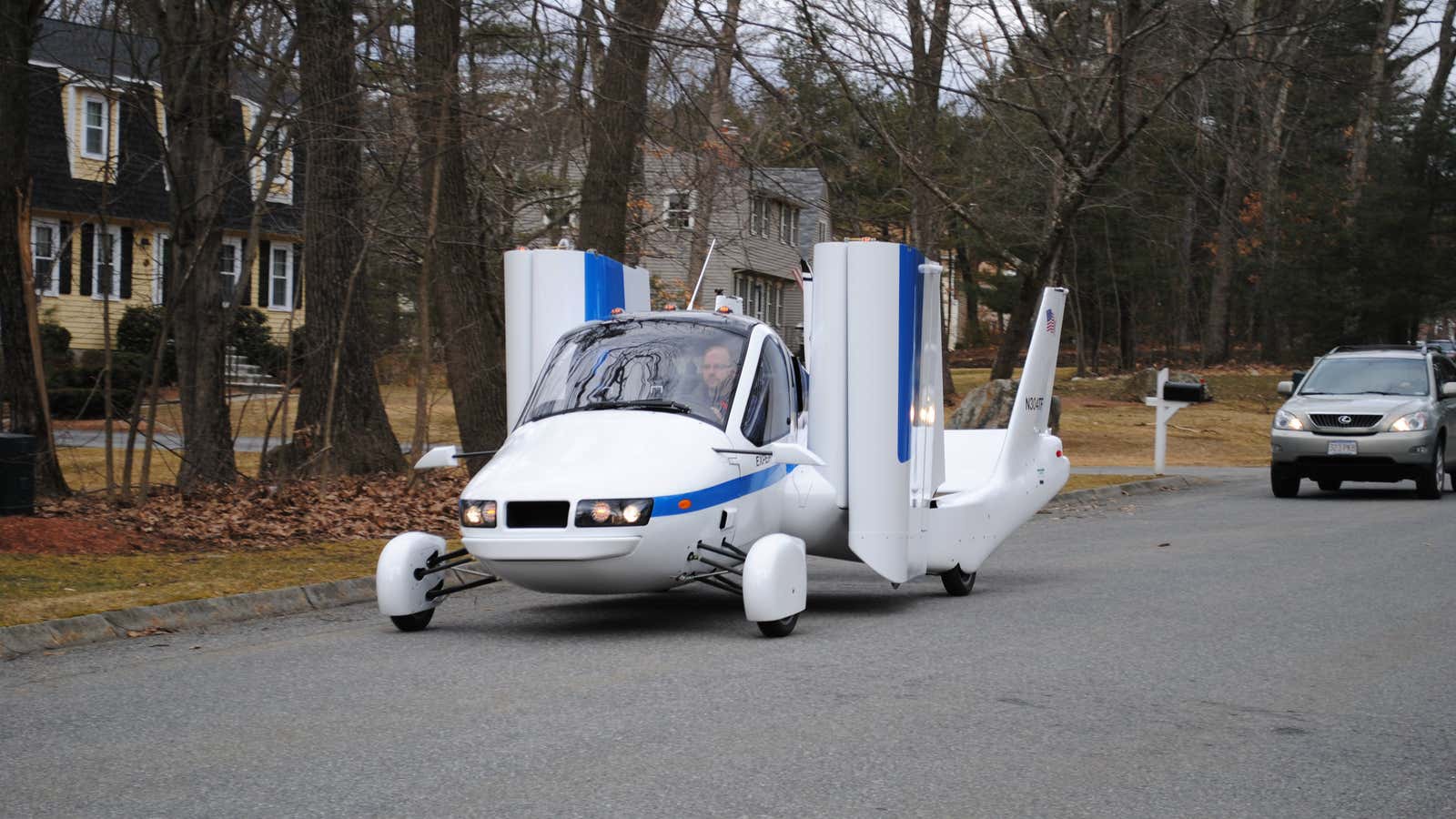On the growing list of Chinese acquisitions of US-based companies, one recent deal reads like something from a science fiction novel. Geely, an automaker from Hangzhou, China, announced on Nov. 13 it had snapped up Terrafugia, a Massachusetts-based startup building a “flying car.”
Average consumers likely haven’t heard of either of these companies. But it’s quite possible they will be hearing more from at least one of them in the future. Geely’s purchase of Terrafugia is merely the latest in a string of purchases the Chinese company has made overseas. And it shows how the little-known car maker is worth watching, as new tech giants and legacy brands compete for dominance in the automotive industry’s next wave.
Zhejiang Geely Holding Group was founded in 1986, making it one of the earlier Chinese car makers to start up with no formal ties to the government. It sells cars under its own brand in China, where it remains a bit player dwarfed by state-owned enterpreises. Geely Auto, its Hong Kong-listed unit, captured just 3.1% of China’s passenger car market in 2016, according to the company’s most recent annual report (pdf, page 14). But it’s nevertheless the number-two privately-owned car maker, and analysts expect its take of the domestic market to increase in the coming years.
Geely Holding shocked the global auto industry when it purchased Volvo from Ford for $1.8 billion in 2010. In the year before the deal, the Swedish carmaker had pre-tax losses of $653 million on $12.4 billion in revenue. Yet Geely successfully reinvigorated the brand—in 2016, it earned operating profits of $1.24 billion, and sold a record 534,332 cars. Analysts and Volvo employees ascribe the turnaround to Geely’s access to the China market (the country is Volvo’s second-largest market, behind Western Europe), and also its willingness to finance Volvo while still preserving the Swedish team’s autonomy.
“You could almost say that by not doing that much in terms of changing the operations of Volvo, they did a lot of good,” says James Chao, who researches China’s car industry at IHS Markit. “Their crossovers and their SUV lineup is pretty attractive, and that’s under Geely’s watch,” he adds.
Geely’s overseas expansion
Following that deal, Geely has made more purchases of overseas car makers.
In 2013 it bought London Taxi Company (paywall), the UK-based manufacturer of London’s municipal cabs (then known as Manganese Bronze), for £11 million ($17.5 million). Over four years later, it opened a plant in the West Midlands to produce electric taxis. “This a fantastic story of a company that was on its knees in 2013,” a regional trade union representative told the Telegraph upon the plant’s launch.
This year Geely purchased a controlling stake in UK-based Lotus, the sports car brand best known for its appearance in a James Bond film, and for helping engineer Tesla’s first vehicle, the Roadster. It closed that deal alongside a 49.9% stake in Malaysia-based carmaker Proton (both Proton and Lotus were owned by Malaysian conglomerate DRB-Hicom). The former purchase could give Geely a shot at reviving an iconic luxury, while the latter could help it make inroads into Southeast Asia.
Terrafugia, however, is an entirely different company than the other ones Geely has bought or invested in.
Founded in 2006 by a group of MIT alumni, Terrafugia has spent the past decade building vehicles that travel both on road and in the air—but its most fully-realized vehicle is more of a mutant “car-plane” than a Back to the Future-style auto that glides nimbly through space.
As Quartz’s Mike Murphy explains, the companies building “flying cars” often have very different interpretations of that phrase. Aeromobil’s $1 million vehicle has two car-esque front wheels attached to a head that contains a cockpit, for example, while Ehang’s 184 resembles a larger version of the drones it has been selling for years.
Judging by video demonstrations, Terrafugia’s most recent model, the Transition, acts like a car when on the road and a plane when in the air. According to the company, when grounded, it can park in an ordinary garage, and travel at “highway speeds” using unleaded automotive gasoline. It expands retractable wings to liftoff from a runway, and can move at a cruise range of 400 miles and a top speeds of up to 100 miles per hour.
The Transition has received permission from The National Highway Traffic Safety Administration (NHTSA) to hit the road in the US, but Terrafugia says it won’t be sold to consumers until mid-2019.
By 2023, meanwhile, Terrafugia hopes to release a vertical take-off and landing (VTOL) vehicle that can launch into flight by hovering straight up—rather than launching upwards and horizontally, like an airplane. The company released a video (link) showing the design for a vehicle it call the TF-X, which looks much closer to a sci-fi style “flying car.”
Despite those deadlines, Terrafugia has a habit of over-promising and under-delivering. As far back as 2008, the company has consistently missed its deadlines to put the Transition into the hands of consumers.
It’s possible that Geely could bring Terrafugia out of a rut, much like how it revived Volvo. Terrafugia says its engineer headcount has tripled in the past quarter, and Geely has appointed Chris Jaran, former head of Bell Helicopter China, as Terrafugia’s new CEO.
But Volvo and Geely’s other vehicles are all more-or-less traditional cars. Terrafugia’s “flying cars” are something entirely new, and they’ll be up against efforts from Google, Uber, Airbus, and a bevvy of other companies. Many of these companies have completely different ideas of what the “flying car” of the future will actually look like. At this point, Geely’s guess is as good as anyone else’s.
